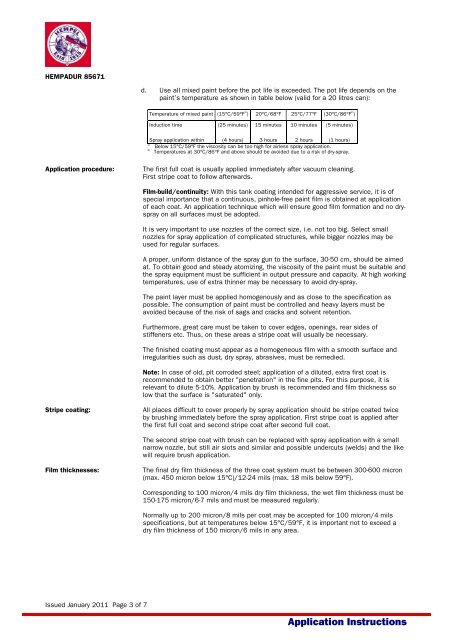English (United Kingdom) - Paul Wurth
English (United Kingdom) - Paul Wurth
English (United Kingdom) - Paul Wurth
- TAGS
- wurth
- www.paulwurth.com
Create successful ePaper yourself
Turn your PDF publications into a flip-book with our unique Google optimized e-Paper software.
HEMPADUR 85671<br />
Issued January 2011 Page 3 of 7<br />
d. Use all mixed paint before the pot life is exceeded. The pot life depends on the<br />
paint’s temperature as shown in table below (valid for a 20 litres can):<br />
Temperature of mixed paint (15°C/59°F 1)<br />
) 20°C/68°F 25°C/77°F (30°C/86°F 2)<br />
)<br />
Induction time<br />
(25 minutes)<br />
15 minutes<br />
10 minutes<br />
(5 minutes)<br />
Spray application within (4 hours) 3 hours 2 hours (1 hours)<br />
Below 15°C/59°F the viscosity can be too high for airless spray application.<br />
Temperatures at 30°C/86°F and above should be avoided due to a risk of dry-spray.<br />
1)<br />
2)<br />
Application procedure: The first full coat is usually applied immediately after vacuum cleaning.<br />
First stripe coat to follow afterwards.<br />
Film-build/continuity: With this tank coating intended for aggressive service, it is of<br />
special importance that a continuous, pinhole-free paint film is obtained at application<br />
of each coat. An application technique which will ensure good film formation and no dryspray<br />
on all surfaces must be adopted.<br />
It is very important to use nozzles of the correct size, i.e. not too big. Select small<br />
nozzles for spray application of complicated structures, while bigger nozzles may be<br />
used for regular surfaces.<br />
A proper, uniform distance of the spray gun to the surface, 30-50 cm, should be aimed<br />
at. To obtain good and steady atomizing, the viscosity of the paint must be suitable and<br />
the spray equipment must be sufficient in output pressure and capacity. At high working<br />
temperatures, use of extra thinner may be necessary to avoid dry-spray.<br />
The paint layer must be applied homogenously and as close to the specification as<br />
possible. The consumption of paint must be controlled and heavy layers must be<br />
avoided because of the risk of sags and cracks and solvent retention.<br />
Furthermore, great care must be taken to cover edges, openings, rear sides of<br />
stiffeners etc. Thus, on these areas a stripe coat will usually be necessary.<br />
The finished coating must appear as a homogeneous film with a smooth surface and<br />
irregularities such as dust, dry spray, abrasives, must be remedied.<br />
Note: In case of old, pit corroded steel; application of a diluted, extra first coat is<br />
recommended to obtain better "penetration" in the fine pits. For this purpose, it is<br />
relevant to dilute 5-10%. Application by brush is recommended and film thickness so<br />
low that the surface is "saturated" only.<br />
Stripe coating: All places difficult to cover properly by spray application should be stripe coated twice<br />
by brushing immediately before the spray application. First stripe coat is applied after<br />
the first full coat and second stripe coat after second full coat.<br />
The second stripe coat with brush can be replaced with spray application with a small<br />
narrow nozzle, but still air slots and similar and possible undercuts (welds) and the like<br />
will require brush application.<br />
Film thicknesses: The final dry film thickness of the three coat system must be between 300-600 micron<br />
(max. 450 micron below 15°C)/12-24 mils (max. 18 mils below 59°F).<br />
Corresponding to 100 micron/4 mils dry film thickness, the wet film thickness must be<br />
150-175 micron/6-7 mils and must be measured regularly.<br />
Normally up to 200 micron/8 mils per coat may be accepted for 100 micron/4 mils<br />
specifications, but at temperatures below 15°C/59°F, it is important not to exceed a<br />
dry film thickness of 150 micron/6 mils in any area.<br />
Application Instructions




